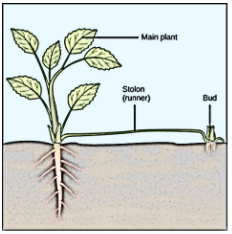
Potato is a modified
A. Petiole
B. Stem
C. Root
D. Leaf
Answer
489.3k+ views
Hint: The roots, stem, and leaves undergo modifications to store food in order to use under unfavorable conditions. Stems which grow from underground stems are called stolon.
Complete answer:
In order to answer this question, we will first have to learn about modified roots, stem, leaf and petiole.
Modified roots are roots itself which change the structure to get adapted to the surrounding. These include 7 subtypes. Its examples include carrot, sweet potato.
A modified stem is part of a plant that stores food, and this food further is used by the plant in its dormancy period. A potato (tuber) is a very famous example under this category. Examples include potato, jasmine.
A petiole is also known as a leaf stalk. It helps to join leaf blades with stems. Moreover, the modified petiole is also called a phyllode. Examples include: euphorbia royleana.
Leaf is frequently modified for various purposes other than photosynthesis. Examples include Pisum sativum (tendril), Opuntia (spines), etc.
Sweet potato is a modified storage root (of fibrous roots). Whereas potato is a stem which is developed on the underground stems. These underground stems are named stolon.
Potato is a tuber that has buds (eyes), that grow leaves and stems from them while roots do not possess such properties.
Hence, from above definitions and examples we know that the correct answer is stem.
We can refer to the below image of an underground stem (stolon), for better understanding.

Additional information: Potato tubers have buds that grow leaves and stems from them whilst roots do not have such properties.
Note: The ends of stolon get swollen and form a tuber.
Potato is a stem whereas sweet potato is a root. This is because the stem of the potato undergoes modifications to store food. Whereas in a sweet potato, the roots undergo modifications in order to store the food.
Complete answer:
In order to answer this question, we will first have to learn about modified roots, stem, leaf and petiole.
Modified roots are roots itself which change the structure to get adapted to the surrounding. These include 7 subtypes. Its examples include carrot, sweet potato.
A modified stem is part of a plant that stores food, and this food further is used by the plant in its dormancy period. A potato (tuber) is a very famous example under this category. Examples include potato, jasmine.
A petiole is also known as a leaf stalk. It helps to join leaf blades with stems. Moreover, the modified petiole is also called a phyllode. Examples include: euphorbia royleana.
Leaf is frequently modified for various purposes other than photosynthesis. Examples include Pisum sativum (tendril), Opuntia (spines), etc.
Sweet potato is a modified storage root (of fibrous roots). Whereas potato is a stem which is developed on the underground stems. These underground stems are named stolon.
Potato is a tuber that has buds (eyes), that grow leaves and stems from them while roots do not possess such properties.
Hence, from above definitions and examples we know that the correct answer is stem.
We can refer to the below image of an underground stem (stolon), for better understanding.

Additional information: Potato tubers have buds that grow leaves and stems from them whilst roots do not have such properties.
Note: The ends of stolon get swollen and form a tuber.
Potato is a stem whereas sweet potato is a root. This is because the stem of the potato undergoes modifications to store food. Whereas in a sweet potato, the roots undergo modifications in order to store the food.
Recently Updated Pages
Master Class 10 Computer Science: Engaging Questions & Answers for Success

Master Class 10 Maths: Engaging Questions & Answers for Success

Master Class 10 English: Engaging Questions & Answers for Success

Master Class 10 General Knowledge: Engaging Questions & Answers for Success

Master Class 10 Science: Engaging Questions & Answers for Success

Master Class 10 Social Science: Engaging Questions & Answers for Success

Trending doubts
State and prove Bernoullis theorem class 11 physics CBSE

Raindrops are spherical because of A Gravitational class 11 physics CBSE

What are Quantum numbers Explain the quantum number class 11 chemistry CBSE

Write the differences between monocot plants and dicot class 11 biology CBSE

Why is steel more elastic than rubber class 11 physics CBSE

Explain why a There is no atmosphere on the moon b class 11 physics CBSE




